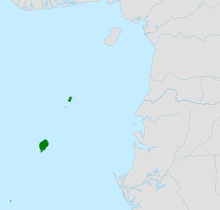Island bronze-naped pigeon
| Island bronze-naped pigeon | |
|---|---|

| |
| São Tomé island | |
| Scientific classification | |
| Domain: | Eukaryota |
| Kingdom: | Animalia |
| Phylum: | Chordata |
| Class: | Aves |
| Order: | Columbiformes |
| Family: | Columbidae |
| Genus: | Columba |
| Species: | C. malherbii
|
| Binomial name | |
| Columba malherbii Verreaux, J & Verreaux, É, 1851
| |

| |
The island bronze-naped pigeon (Columba malherbii), also known as the São Tomé bronze-naped pigeon or São Tomé pigeon, is a
The species is
Taxonomy
The island bronze-naped pigeon was
The island bronze-naped pigeon is one of 35 species in the genus Columba in the pigeon family Columbidae.[5] It is occasionally considered to be the same species as the western and eastern bronze-naped pigeons; these three species are also sometimes placed in the subgenus Turturoena.[7]
Description

The island bronze-naped pigeon is a small, darkish pigeon with a total length of 28 cm (11 in) and a wing length of 178–182 mm (7.0–7.2 in) in males and 165–176 mm (6.5–6.9 in) in females. In adult males, the crown (top of the head), forecrown, hindcrown, back of the neck, and mantle are slaty-grey, with the last three having a glossy pink or green sheen. The wings and back down to the top of the tail are blackish-grey with a greenish tinge. The chin and throat are buffy-white, while the breast and belly are pale ashy-grey. The vent and underside of the tail are rufous with grey spots, while the upper side of the tail is blackish-grey with a yellowish-brown wash on the edges of the rectrices. The eye-ring is narrow and light grey and the iris is pale grey. The bill is dark grey with a pale tip, and the feet are red.[7][6]
Females are similar to males, but have browner undersides, with fine yellow-brown speckling on the lower breast and upper belly. The lower belly down to the vent is pale rufous with grey speckling. The upperparts are duller and less glossy, and the outer tail feathers are more rusty-orange. Juveniles are like females but browner overall, with less iridescence on the back of the neck, ochre or rufous freckles on the upperparts, and buff edges to the feathers of the crown and forecrown.[7][6]
The species is similar in appearance to the closely related western and eastern bronze-naped pigeons, but does not co-occur with them in any part of its range. On São Tomé, it may be confused with the
Vocalisations
The advertising call consists of two hoarse hoots followed by 15–20 stuttering notes, "rhuuuw...rhuuw...rhu-tu-tu-tu-tutututu", with the later notes being shorter and eventually fading away. It is quite distinct from the calls of the other bronze-naped pigeons, and is more reminiscent of Streptopelia doves in its tone and structure. The species also makes nasal "wuh..wuh..." calls when feeding.[7]
Distribution and habitat
The island bronze-naped pigeon is
Behaviour and ecology
The island bronze-naped pigeon is an
Breeding takes place from November to January on Príncipe and February onwards on São Tomé.[6] It is more conspicuous during the breeding season and is more easily seen in forests, savannas, and near the coast.[1] Nests are sturdy platforms built 5–12 m (16–39 ft) up in trees, usually near the trunk, in secondary forests, Erythrina, or cocoa tree plantations. Eggs are dirty-white and laid in clutches of one or two. Nothing is known about its incubation and fledging.[7][6]
Conservation
The island bronze-naped pigeon is common in parts of its range, but is considered
The main threat to the species is hunting for its meat; the species is a favoured prey and is popular at bars and parties.[1] Birds, especially pigeons, are in high demand in restaurants on São Tomé, and a majority of hunters on the island hunt to sell the meat, although some also hunt for food or for enjoyment.[12] Island bronze-naped pigeons are the preferred prey for commercial hunters on São Tomé, with the species accounting for nearly 60% of the birds captured by commercial hunters. In all, an estimated 8,601–29,743 island bronze-naped pigeons are harvested on São Tomé annually; although this is currently within sustainable levels of extraction for the species,[13] hunting pressure on the pigeon may be increasing and a substantial number of young children are involved in hunting. Some birds are also captured alive for captive breeding.[1]
The island bronze-naped pigeon is able to make use of secondary vegetation and somewhat degraded habitats, making it somewhat tolerant of
References
- ^ . Retrieved 10 October 2023.
- OCLC 1764157 – via Biodiversity Heritage Library.
- .
- ISBN 978-1-4081-2501-4 – via Internet Archive.
- ^ Rasmussen, Pamela, eds. (July 2023). "Pigeons". IOC World Bird List Version 13.2. International Ornithologists' Union. Retrieved 11 October 2023.
- ^ OCLC 701718514.
- ^ S2CID 241077126, retrieved 2023-10-10
- .
- .
- ISSN 0959-2709.
- ISSN 1352-481X.
- ^ ISSN 0030-6053.
- ^ Carvalho, Mariana Bastos (2014). Hunting and conservation of forest pigeons in São Tomé (PDF). Lisbon: Universidade de Lisboa. pp. 148, 151.

